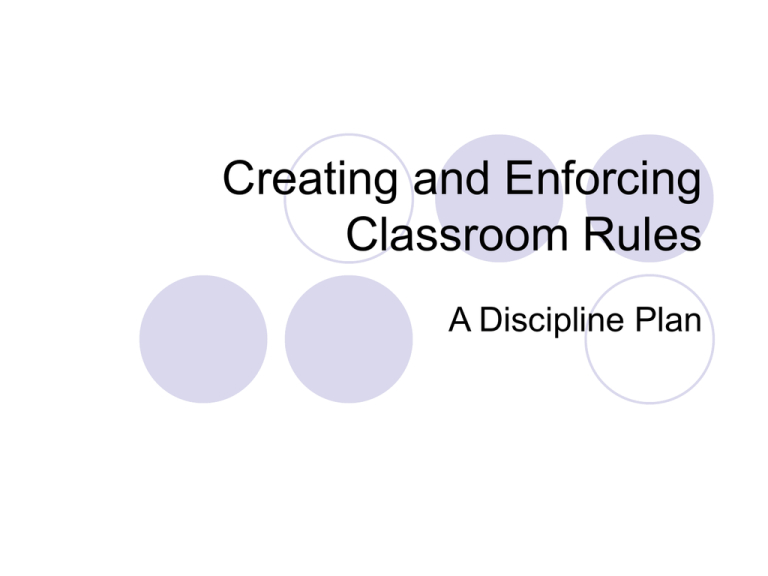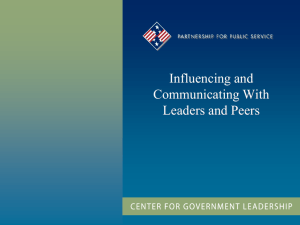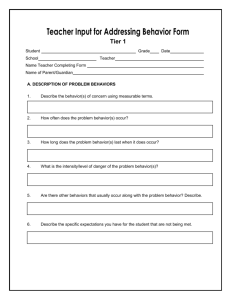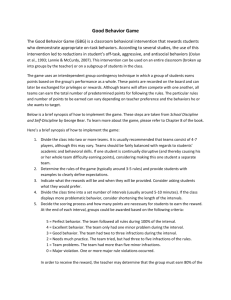Creating and Enforcing Classroom Rules
advertisement

Creating and Enforcing Classroom Rules A Discipline Plan Basic Structure for a Discipline Plan 1. Rules: State what the expected behaviors are. 2. Consequences: Penalties - State what the student chooses to accept if a rule is broken. Rewards - State what the student receives for appropriate behavior. 1. Rules Rules state what you expect of student behavior. They should be communicated verbally and in writing to the students and their parents. To give students ownership of the rules, it is a good idea to ask them to participate in identifying the behaviors you should be able to expect. (You have the right to add rules if they left something out!) You should limit your list to three to five rules. Kinds of Rules General Cover many behaviors, offers flexibility Specifics must be explained Examples Respect yourself and others. Take care of your school. Be prepared to enter class. (You have to explain what respecting, taking care, and being polite means.) Specific Clearly cover one behavior Can go beyond that 3-5 limit Examples • Be in class on time. • Keep your hands to yourself. • Have all materials ready to use when the bell rings. Bad Rules Address academic performance Using a pencil, doing homework, turning in work are all procedures and/or academic. A discipline plan addresses behavior only Are written in a negative voice Examples: No cursing. No talking while the teacher is talking. State only the expected behaviors in a positive voice if at all possible. (Be polite.) 2. Consequences Can be positive (rewards) or negative (penalties). Mostly we associate the term “consequences” with something negative. Should be emphasized as choices. (A choice to break a rule results in a consequence – a penalty.) Penalties May be given out after student receives warning(s) and a reminder of the rules. (Checkmarks by name on board, strikes, etc.) Should be reasonable and logical. A reasonable consequence follows logically from the behavior. Logical consequences teach the students to choose between acceptable and unacceptable behaviors. (More on this…next slide.) Should be given out immediately, privately and quietly, while not stopping instruction. Examples of Logical and Illogical Consequences Behavior Logical Consequence Illogical Consequence Chewing gum Disposes of it Get sent to office Turns in sloppy paper Redoes paper Paper not accepted Walks in noisily Walks in again (This is a procedure to be rehearsed, not punished.) Stands in front of class and explains behavior (More attention for you!) Passes paper in incorrectly Passes paper in correctly 3 times (A procedure.) Gets silent lunch Does not bring pen or pencil Borrows one from teacher but has to sign it out Student sits without one Tardy Gets silent lunch Stay after class 3. Rewards Are posted like your rules and penalties. Have a time factor associated with when they are given (daily, weekly, etc.). Are reasonable and logical. Are earned, not given (and students know this). According to Dr. Wong: “The time has come in education when the wholesale bribery system of giving out endless supplies of stickers, candies, and other tangibles has got to come to a halt. Let’s stop the ‘what’s in it for me?’ welfare and bribery system…Self-discipline…is what [it’s] all about. You can’t teach self-discipline if the students are always looking for more ‘goodies.’” Dr. Loomis doesn’t think students should be given tangible rewards for behaving like human beings. (You don’t get a piece of candy because you didn’t talk back to the teacher today.) Example Logical Rewards Thirty minutes of free time on Friday to work on homework from any class. (No pizza or ice cream parties.) A note from the teacher on special paper to the student. A note or a phone call home. A smile and a “thank you.” In summary: Write only 3 to 5 classroom rules. Make them positively stated, if at all possible. Make your consequences (penalties) reasonable and logical. Make your rewards intangible.* *MANY teachers of young students reward students with tangibles and parties after they (the students) either accumulate points or tokens or if they have not lost all the points or tokens they started out with. That’s fine…for now. I’d encourage you to move away from this “token economy” system as you become more skilled and comfortable with classroom management.



